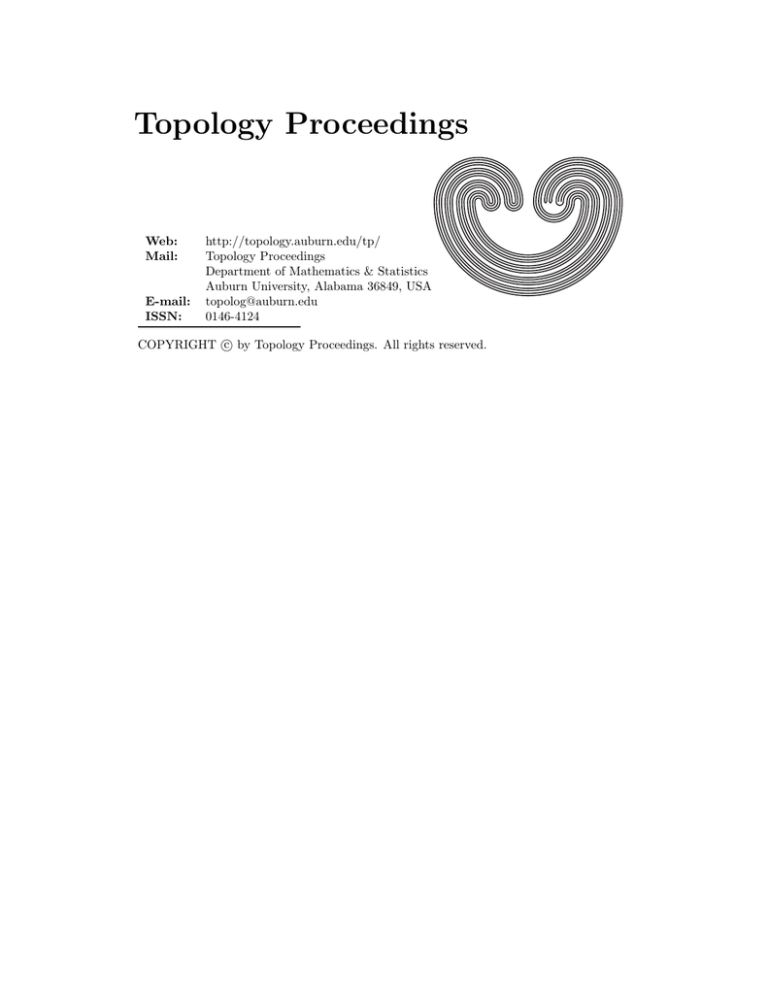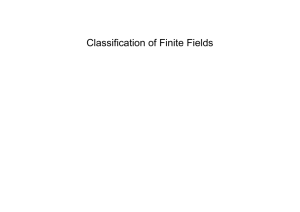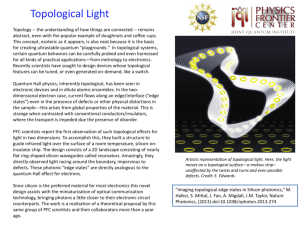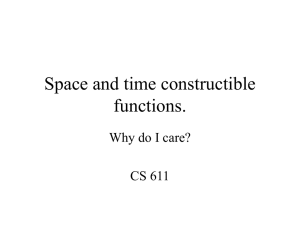
Topology Proceedings
Web:
Mail:
E-mail:
ISSN:
http://topology.auburn.edu/tp/
Topology Proceedings
Department of Mathematics & Statistics
Auburn University, Alabama 36849, USA
topolog@auburn.edu
0146-4124
c by Topology Proceedings. All rights reserved.
COPYRIGHT °
Topology Proceedings
Volume 24, Summer 1999, 187–198
SPLITTABILITY, CONSTRUCTIBLE SETS AND
PARTIAL ORDERS
A. J. Hanna and T. B. M. McMaster
Abstract
The power and utility of cleavability (also known
as splittability) has been well established by A. V.
Arhangel’skiı̌ and his associates within a topological framework. The definition was transferred to
partially ordered sets by D. J. Marron and T. B.
M. McMaster. The connections between topology
and order are here further exploited as we examine properties derived from splitting over simple
finite partial orders. All spaces are assumed T0.
The minimal topologies for these properties are
readily derived from splittability considerations.
Introduction
Given a topological space X it is well known that a quasi-order
is generated under the relation x ≤ y if and only if x ∈ {y}.
Moreover, if X is a T0 topology then (X, ≤) is a partially ordered set (poset). This connection is highly suggestive of how
splittability might be treated for posets. It should be noted that,
for infinite posets at least, the correspondence between topologies and posets is many-to-one. We review some splittability
results for posets and consider the topological implications. A
key influence in our approach is a paper [1] by J-P. Allouche
concerning constructible sets.
Mathematics Subject Classification: 06A06, 54C99
Key words: splittable, locally closed, constructible, partial order.
188
A. J. Hanna and T. B. M. McMaster
In identifying those topological spaces that split over a given
space (or its corresponding partial order, suitably ‘topologised’)
we obtain a topological invariant. The invariants we consider
are closely linked to constructible sets. Joint work with S. D.
McCartan [4] has shown that related minimality results can be
intuitively derived from a splittability approach. In this paper
we present the preliminary material and show how the invariants
arise naturally from partial orders.
Definition 1. [2] A topological space X is splittable over a class
P of topological spaces if for every subset A of X there exists a continuous map f : X → Y ∈ P such that f (A) ∩
f (X \ A) = ∅. We use the term onto splittable to mean that the
splitting maps can be chosen to be onto. The space X is said to
be pointwise splittable over P if splitting maps can be found for
every singleton subset of X. When working with posets we need
only replace the “continuous map f ” concept with an increasing
map (i.e. x ≤ y in X implies f (x) ≤ f (y)). A class of spaces P
is said to be a splittability class if X splittable over P implies
X ∈ P.
For background information the reader is referred to [2, 3] for
splittability over topological spaces and to [6, 7, 8] for splittability over partially ordered sets.
Definition 2. Given a poset (X, ≤), we use the notation ↑ x =
{y ∈ X : x ≤ y} and ↓ x = {y ∈ X : y ≤ x}. The weak topology, W, is the topology on X whose proper closed subsets are
generated by the family of subsets {↓ x : x ∈ X}. The Alexandroff topology, A, is the topology on X whose open sets are the
increasing subsets of X. We use Cn to denote (interchangeably) the poset on {1, 2, . . . , n} with the usual ordering and the
corresponding topology obtained by imposing the weak topology.
Thus Cn is the n-point T0 nested space (where by nested we
intend a space whose open subsets are linearly ordered by setinclusion). Indeed, all posets in this paper are considered as
topological spaces when endowed with the weak topology.
SPLITTABILITY, CONSTRUCTIBLE SETS AND ...
189
Definition 3. Let X be a poset that contains no infinite chains.
By the height of X we shall mean the cardinality of the largest
chain in X. The height of a point x ∈ X is the height of the
poset ↓ x.
The following key result of Marron’s [6] identifies precisely
which finite posets are splittable over the n-point chain.
Theorem 4. Let X be a finite poset; then X is splittable over
Cn if and only if
(i) X contains no n + 1 element chain, and
(ii) X contains no disjoint n element chains.
Clearly Cn will split over any poset of height n. Likewise, it
can be shown that any poset of height n will split over the poset
shown below. We will refer to this poset as the ladder of height
n denoted by Ln. Hence Cn and Ln represent the two extremes
of splittability for posets of height n.
xn
x2
x1
i
iyn
@
@
@
@i
i
i
i
@
@
@
@ iy
i
2
@
@
@
@ iy
i
1
Definition 5. Let X be a topological space. A subset of X is
locally closed if it can be expressed as the intersection of an open
set and a closed set. We will say that X is:
− door if every subset A ⊆ X is either open or closed,
190
A. J. Hanna and T. B. M. McMaster
− submaximal if every subset A ⊆ X is locally closed,
− TESC if every subset A ⊆ X is a finite union of locally closed
sets.
Recall [1] that the constructible sets in a topological space are
the sets in the Boolean algebra generated by the closed and the
open sets. It can be shown that the constructible sets are precisely
those which are finite unions of locally closed sets. Hence a space
is TESC if and only if every subset is constructible.
Results
Observing that every finite T0 space is TD (that is, every singleton is locally closed) it is clear since every subset is a finite
union of singletons that finite T0 spaces are TESC . It is clear
that every TESC space is TD and therefore T0. To see that there
exist infinite TESC spaces one need only note that any included
point topology is door and therefore TESC .
Lemma 6. Every finite T0 space is splittable over a finite T0
nested space.
Proof. Recall that minimal T0 topologies are nested [5]. If X
is an n-point T0 space then X is stronger than a minimal T0
topology in the lattice of topologies definable on the finite set
2
X. Hence X is splittable over a finite T0 nested space.
Theorem 7. If X is splittable over a class of TESC spaces then
X is TESC .
Proof. Let P be such a class of TESC spaces. Suppose that
A ⊆ X and choose continuous f : X → Y ∈ P that splits X
along A over Y . Since Y is TESC we can write:
f (A) = (B1 ∩ C1) ∪ (B2 ∩ C2) ∪ . . . ∪ (Bn ∩ Cn ),
where each Bi is open in Y and each Ci is closed in Y . Now
SPLITTABILITY, CONSTRUCTIBLE SETS AND ...
A=f
−1
f (A) =
n
[
f
−1
(Bi ∪ Ci) =
n
[
1
191
(f −1 (Bi ) ∩ f −1 (Ci )).
1
Hence A is the union of finitely many locally closed sets.
2
When concentrating solely on partially ordered sets we can
easily describe the posets that are splittable over chains and
ladders. The corresponding topological results are more difficult
to formulate. Before making any attempt to do so we adopt the
notation of Allouche [1].
Definition 8. If X is a topological space and A ⊆ X we recursively define:
n∨
∨
A = A ∩ X \ A,
(
∨
(n−1)∨
A=
A
)
for n > 1.
Theorem 9. [1] Let X be a topological space with A ⊆ X.
(i)
n∨
( A ) is a decreasing sequence of (closed) sets.
(2n)∨
(ii) A is the union of n locally closed sets if and only if A = ∅.
Hence the smallest such n is the smallest integer n such
(2n)∨
that A = ∅. Furthermore the set A admits the following
canonical decomposition into n disjoint locally closed sets:
(
∨
) (
2∨
3∨
)
A = A \ A ∪ A \ A ∪ ...∪
(
(2n−2)∨
A
(2n−1)∨
\
A
).
(iii) The set A is the union of n locally closed sets and a closed
(2n+1)∨
set if and only if
A = ∅. Hence the smallest such n is
(2n+1)∨
the smallest integer n such that
A = ∅.
Theorem 10. If X is TESC then X is splittable over the finite
T0 nested spaces.
192
A. J. Hanna and T. B. M. McMaster
Proof. If A is a subset of X then A is a finite union of locally
(2n)∨
closed sets. Hence we can find n ∈ N such that A = ∅. We
can write A in its canonical form as in Theorem 9 (ii) above and
define a map f : X → C2n+1 by:
f (x) =
1
2
:
(2n−1)∨
if x ∈
A
(2n−2)∨
if x ∈
(2n−1)∨
\
A
(2n−k)∨
k
if x ∈ A \
:
∨
2n
if x ∈ A \ A
2n + 1 otherwise.
A
(2n−k+1)∨
A
n∨
( )
Recall from Theorem 9 that A is a decreasing sequence of
closed sets so we see that the map f is continuous. Moreover we observe that f (A) = {2, 4, 6, . . . , 2n} while f (X \ A) =
{1, 3, 5, . . . , 2n + 1} so f splits X along A over C2n+1 .
2
Corollary 11. A topological space X is TESC if and only if X
is splittable over {Cn : n ∈ N}.
Lemma 12. [1] Let A be a subset of a topological space X. For
any integer n:
(2n+1)∨
(2n)∨
(2n+2)∨
A = A ∩ (X \ A)
and
A =
(2n+1)∨
A
∩ A.
Lemma 13. Let X be a topological space. Let A ⊆ X and set
B = X \ A. For all n ∈ N we have:
n∨
n∨
(n+1)∨
A∩B ⊆ A
(n+1)∨
∪ B.
SPLITTABILITY, CONSTRUCTIBLE SETS AND ...
193
Proof. Using Lemma 12 we see that:
n∨
n∨
A∩B =
n∨
n∨
n∨
n∨
( A ∩ B ) ∩ (A ∪ B)
n∨
n∨
=
( A ∩ B ∩ A) ∪ ( A ∩ B ∩ B )
=
=
n∨
n∨
n∨
( A ∩ ( B ∩ A)) ∪ (( A ∩ B ) ∩ B ) n even
(
n∨
n∨
(n+1)∨
n∨
(A∩
B
n∨
n∨
) (
(n+1)∨
B
)∪(
n∨
(n+1)∨
n∨
∩B ∪ A ∩
A
(n+1)∨
⊆
n∨
(( A ∩ A) ∩ B ) ∪ ( A ∩ ( B ∩ B )) n odd
B
(n+1)∨
A
) n odd
n∨
∩B
) n even
(n+1)∨
∪ A.
2
Theorem 14. Let X be a topological space. Each subset A ⊆ X
can be expressed as the union of n locally closed sets if and only
if X is splittable over the poset L2n.
Proof. If f is a map that splits X along A over L2n we can
assume that
f (A) ⊆ {x1, x2 , . . . , x2n } and f (X \ A) ⊆ {y1, y2, . . . , y2n }.
Hence
A = f −1 f (A) = f −1 ({x1, x2, . . . , x2n})
n
[
f −1 ({x2i−1 , x2i})
=
=
1
n
[
=
n
[
f −1 (↑ (x2i−1)∩ ↓ (x2i ))
1
1
(
f −1 (↑ (x2i−1)) ∩ f −1 (↓ (x2i))).
194
A. J. Hanna and T. B. M. McMaster
We see that A is the union of n locally closed sets.
Conversely suppose that each subset A ⊆ X has the stated
property. Set B = X \ A. Since both A and B are unions of n
locally closed sets, from Theorem 9 we have:
∨
2∨
3∨
(2n−2)∨
A =
(A \ A) ∪ ( A \ A) ∪ . . . ∪ (
B =
(B \ B ) ∪ ( B \ B ) ∪ . . . ∪ (
∨
2∨
3∨
(2n−1)∨
\
A
(2n−2)∨
B
A
),
(2n−1)∨
\
B
).
Define a map f : X → L2n given by:
(2n−1)∨
x1 if z ∈ A
(2n−1)∨
y1 if z ∈ B
f (z) =
(2n−i)∨
(2n−i+1)∨
(2n−i+1)∨
−
∪
x
if
z
∈
A
A
B
i
(2n−i+1)∨
(2n−i+1)∨
y if z ∈ (2n−i)∨
∪
.
B −
A
B
i
(
(
(2n−1)∨
Note that if z ∈
(2n)∨
(2n−1)∨
∩
A
)
)
B
then, by Lemma 12,
(2n)∨
i∨
i∨
z ∈ A ∪ B = ∅ using Theorem 9 (ii). Likewise if z ∈ A ∩ B
(i+1)∨
(i+1)∨
then, by Lemma 12, z ∈ A ∪ B . Clearly f is a well defined
function, which is also continuous since
f −1 (↓ (xi )) =
f −1 (↓ (yi )) =
(2n−i)∨
A
(2n−i+1)∨
∪
(2n−i)∨
B
and
B
(2n−i+1)∨
∪
A
.
By inspection we can see that f splits X along A over L2n,
completing the proof.
2
Theorem 15. Let X be a topological space. Each subset A ⊆ X
can be expressed as the union of a closed set and n locally closed
sets if and only if X is splittable over the poset L2n+1 .
SPLITTABILITY, CONSTRUCTIBLE SETS AND ...
195
Proof. Similar to proof of Theorem 14.
2
We consider now precisely what topological spaces are splittable over an n-point T0 nested space. We already know that
such a space X must have the property that every subset is constructible. It follows that for each A ⊆ X we can find a least
p∨
p ∈ N such that A = ∅. The obvious question arises: how is p
related to n?
Lemma 16. If X is a topological space that is splittable over
k∨
Ck then A = ∅ for all A ⊆ X.
Proof. We consider only the case when k is even. Suppose
that X splits along A over C2n via a map f , but fails to
split over C2n−1 . We assume that f is onto and that f (A) =
{1, 3, . . . , 2n − 1} while f (X \ A) = {2, 4, 6, . . . , 2n}. Hence we
can express A and X \ A as follows:
A = f −1 f (A) = f −1 ({1, 3, . . ., 2n − 1})
n
[
= f −1 (1) ∪
f −1 (↓ (2k − 1)∩ ↑ (2k − 1)),
2
X \ A = f −1 f (X \ A) = f −1 ({2, 4, . . ., 2n})
n
[
=
f −1 (↓ (2k)∩ ↑ (2k)).
1
We observe that A is the union of a closed set and (n − 1)
locally closed sets while X \ A is the union of n locally closed
(2n−1)∨
sets. Theorem 9 gives
(2n)∨
A =X \ A= ∅.
2
Theorem 17. A topological space X is splittable over Cm if and
only if for each A ⊆ X:
(i)
m∨
A= ∅
(m−1)∨
(ii)
and,
(m−1)∨
A 6= ∅ implies X \ A= ∅.
196
A. J. Hanna and T. B. M. McMaster
Proof.
We consider only the case m = 2n. If X splits over
(2n)∨
(2n−1)∨
Cn then, by Lemma 16, we have A = ∅. If A 6= ∅ then
A cannot be expressed as the union of a closed set and n − 1
locally closed sets. In the proof of Lemma 16 we therefore have
f (A) = {2, 4, . . . , 2n} and f (X \ A) = {1, 3, . . . , 2n − 1}. Hence
X \ A is the union of a closed set and n − 1 locally closed ones,
(2n−1)∨
so by Theorem 9 X \ A= ∅.
Conversely suppose that each subset of X satisfies conditions
(i) and (ii). Let A be a subset of X and set B = X \ A. We
(2n−1)∨
(2n−1)∨
must have A = ∅ or B = ∅. By reworking the proof of
Theorem 10 we see that X splits along A over C2n .
2
It is clear that the complement of a constructible subset is
also constructible. Splittability arguments, similar to those used
previously, yield the following less intuitive result.
n∨
Theorem 18. Let X be TESC and let A ⊆ X such that A = ∅
k∨
(n−1)∨
but A 6= ∅. If k is the least integer such that X \ A= ∅ then
k = n − 1, n or n + 1.
It is not hard to find subsets of ladders and chains to show
that all three cases in Theorem 18 are possible. We can now
interpret Allouche’s operator as a measure of the number of
steps required to construct a given constructible set. Hence a
locally closed set can be constructed in two steps by intersecting
an open set with a closed set. The previous result says that the
complement of a constructible set A can be constructed in the
same number of steps as A, give or take one.
Example 19. Let X = {x1 , x2, x3, y1, y2 , y3} be the space as
shown below. Let A be the subset {x1, x3, y2 }. We examine the
sequence
n∨
( A ), shown shaded in each successive iteration.
SPLITTABILITY, CONSTRUCTIBLE SETS AND ...
x3 x
A
x2 h
x1 x
hy3
x3 h
hy1
x1 h
xy2
∨
x2 x
197
∨
2∨
3∨
A
A
A
hy3
x3 h
xy1
x1 x
hy2
x2 h
hy3
x3 h
hy1
x1 h
hy2
x2 h
hy3
hy2
hy1
A = {x1 , x3, y2} \ {x1 , x3, y2} = {x2, y1 }
2∨
A = {x2 , y1} \ {x2, y1 } = {x1 }
3∨
A = {x1 } \ {x1} = ∅
Both A and X \ A can be expressed as the union of a closed set
and a locally closed set. It is therefore consistent with Allouche
3∨
3∨
that A =X \ A= ∅. We observe also that X will not split along A
over C3 . This shows the necessity of condition (ii) in Theorem
17.
We are now in a position to name the properties identified
and summarize our findings.
Property
∀A ⊆ X
∀A ⊆ X
Qn
A is the union
of n locally
closed sets
2n∨
A =∅
Rn
A or X \ A is
the union of n
locally closed sets
2n∨
A = ∅ or
Pn
A is the union of
n locally closed
sets and a
closed set
(2n+1)∨
A
(2n+1)∨
=∅
S(L2n )
X \ A= ∅
S(C2n+1 )
A
= ∅ or
(2n+1)∨
2n∨
Splittability
equivalent
Sn
A or X \ A is
the union of n
locally closed sets
and a closed set
S(L2n+1 )
X\A =∅
S(C2n+2 )
Note that S0 corresponds to the invariant door and Q1 corresponds to submaximal. It is clear that Qn ⇒ Rn ⇒ Pn ⇒
Sn ⇒ Qn+1 ⇒ TESC for all n ≥ 1. As an example of the type
of minimality results that can now be obtained we present the
following theorem.
Theorem 20. Let X be a set such that x ∈
/ A ⊆ X. The
topology M(A) ∩ E(x) is minimal R1 . Recall that M(A) =
{G ⊆ X : G ⊆ A or A ⊆ G} and E(x) = {G ⊆ X : x ∈
/ G}.
198
A. J. Hanna and T. B. M. McMaster
When working exclusively with Alexandroff topologies it is
useful to note that the increasing maps correspond exactly with
the continuous maps. Moreover, Alexandroff topologies are clearly
principal. These observations prove invaluable in identifying
principal minimal topologies.
References
[1] J-P. Allouche, Note on the constructible sets of a topological space,
Annals New York Academy of Sciences 806 (1996) 1–10.
[2] A. V. Arhangel’skiı̌, The general concept of cleavability of a topological space, Top. Applic. 44 (1992) 27–36.
[3] A. V. Arhangel’skiı̌, A survey of cleavability, Top. Applic. 54
(1993) 141–163.
[4] A. J. Hanna and S. D. McCartan, Constructible sets and minimality, in preparation.
[5] R. E. Larson, Minimal T0 -spaces and minimal TD -spaces, Pac. J.
Math. 31 (1969) 451–458.
[6] D. J. Marron, Splittability in ordered sets and in ordered spaces,
PhD thesis, Queen’s University Belfast, 1997.
[7] D. J. Marron and T. B. M. McMaster, Splittability for finite
partially-ordered sets, Proc. R. Ir. Acad., to appear.
[8] D. J. Marron and T. B. M. McMaster, Splittability for ordered
topological spaces, Bollettino dell’Unione Matematica Italiana (8)
1-B (2000) 213–220.
Department of Pure Mathematics, The Queen’s University of
Belfast, University Road, Belfast, BT7 1NN, UNITED KINGDOM
E-mail address: alan.hanna@dartuk.com
E-mail address: t.b.m.mcmaster@qub.ac.uk








